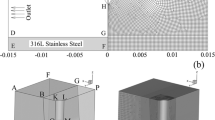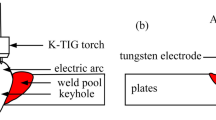Abstract
Narrow gap TIG welding is a high efficiency and low-cost welding technique for heavy structures building. Due to the narrow groove’s constriction, the TIG arc characteristics are different from butt welding. Understanding the unique arc characteristics of narrow gap TIG welding is the foundation for investigating the heat and mass transfer, metallurgic process, as well as process design. This research conducted numerical simulation on the TIG arc plasma in the narrow groove. The effects of welding current and arc length on the arc characteristics are investigated. Results show that, with the welding current increasing, the global velocity magnitude of plasma rises. The evolution of axial velocity and radial velocity has different responses to the current changes. The arc pressure increases drastically, and the global temperature of arc plasma also goes up. With the arc length increasing, global axial velocity rises, but the axial velocity and its gradients decrease near the anode surface. Centripetal radial velocity near the cathode increases, while centrifugal radial velocity rises at the outside of arc plasma and drops near the central axis. The maximum arc pressure on the anode surface decreases. At the lower part of the arc, arc temperature decreases near the central axis and increases at the outside of the arc.















Similar content being viewed by others
Data availability
The raw/processed data required cannot be shared at this time as the data also forms part of an ongoing study.
Abbreviations
- A x :
-
x component of the magnetic vector potential
- A y :
-
y component of the magnetic vector potential
- A z :
-
z component of the magnetic vector potential
- A :
-
Magnetic vector potential
- B x :
-
x component of the magnetic induction intensity
- B y :
-
y component of the magnetic induction intensity
- B z :
-
z component of the magnetic induction intensity
- B :
-
Magnetic field strength
- c p :
-
Specific heat
- e :
-
Electron charge
- F ex :
-
x component of extra volume forces
- F ey :
-
y component of extra volume forces
- F ez :
-
z component of extra volume forces
- g :
-
Acceleration of gravity
- j x :
-
x component of current density
- j y :
-
y component of current density.
- j z :
-
z component of current density
- j e :
-
Electron current density
- k :
-
Thermal conductivity
- K B :
-
Stephen-Boltzmann constant
- q a :
-
Additional heat flux on the anode surface
- S φ :
-
Additional energy source term
- T :
-
Temperature
- t :
-
Time
- U :
-
Radiation losses
- u :
-
x component of the arc plasma velocity
- v :
-
y component of the arc plasma velocity
- w :
-
z component of the arc plasma velocity
- ρ :
-
Mass density of arc plasma
- σ :
-
Electric conductivity
- μ 0 :
-
Permeability of the vacuum
- ϕ a :
-
Work function
- ε :
-
Emissivity of anode
References
Wang J, Sun Q, Zhang T, Zhang S, Liu Y, Feng J (2018) Arc characteristics in alternating magnetic field assisted narrow gap pulsed GTAW. J Mater Process Technol 254:254–264. https://doi.org/10.1016/j.jmatprotec.2017.11.042
Li W, Yu R, Huang D, Wu J, Wang Y, Hu T, Wang J (2019) Numerical simulation of multi-layer rotating arc narrow gap MAG welding for medium steel plate. J Manuf Process 45:460–471. https://doi.org/10.1016/j.jmapro.2019.07.035
Islam M, Buijk A, Rais-Rohani M, Motoyama K (2015) Process parameter optimization of lap joint fillet weld based on FEM–RSM–GA integration technique. Adv Eng Softw 79:127–136. https://doi.org/10.1016/j.advengsoft.2014.09.007
Murphy AB (2015) A perspective on arc welding research: the importance of the arc, unresolved questions and future directions. Plasma Chem Plasma Process 35:471–489. https://doi.org/10.1007/s11090-015-9620-2
Murphy AB, Nguyen V, Feng Y, Thomas DG, Gunasegaram D (2017) A desktop computer model of the arc, weld pool and workpiece in metal inert gas welding. Appl Math Model 44:91–106. https://doi.org/10.1016/j.apm.2017.01.033
Hsu KC, Etemadi K, Pfender E (1983) Study of the free-burning high-intensity argon arc study of the free-burning high-intensity argon arc. J Appl Phys 1293:1293–1301. https://doi.org/10.1063/1.332195
Tanaka M, Terasaki H, Ushio M, Lowke JJ (2002) A unified numerical modeling of stationary tungsten-inert-gas welding process. Metall Mater Trans A Phys Metall Mater Sci 33:2043–2052. https://doi.org/10.1007/s11661-002-0036-2
Tashiro S, Tanaka M, Nakata K, Iwao T, Koshishi F, Suzuki K, Yamazaki K (2007) Plasma properties of helium gas tungsten arc with metal vapour. Sci Technol Weld Join 12:202–207. https://doi.org/10.1179/174329307X164391
Tanaka M, Tashiro S, Satoh T, Murphy AB, Lowke JJ (2008) Influence of shielding gas composition on arc properties in TIG welding. Sci Technol Weld Join 13:225–231. https://doi.org/10.1179/174329308X283929
Jian X, Wu C, Zhang G, Chen J (2015) A unified 3D model for an interaction mechanism of the plasma arc, weld pool and keyhole in plasma arc welding. J Phys D Appl Phys 48:465504. https://doi.org/10.1088/0022-3727/48/46/465504
Pan J, Hu S, Yang L, Li H (2016) Simulation and analysis of heat transfer and fluid flow characteristics of variable polarity GTAW process based on a tungsten-arc-specimen coupled model. Int J Heat Mass Transf 96:346–352. https://doi.org/10.1016/j.ijheatmasstransfer.2016.01.014
Zhao Y, Chung H (2017) Numerical simulation of droplet transfer behavior in variable polarity gas metal arc welding. Int J Heat Mass Transf 111:1129–1141. https://doi.org/10.1016/j.ijheatmasstransfer.2017.04.090
Wang L, Chen J, Wu C, Luan S (2020) Numerical analysis of arc and droplet behaviors in gas metal arc welding with external compound magnetic field. J Mater Process Technol 116638:116638. https://doi.org/10.1016/j.jmatprotec.2020.116638
Xiang J, Chen FF, Park H, Tanaka K, Shigeta M, Tanaka M, Murphy AB (2020) Numerical study of the metal vapour transport in tungsten inert-gas welding in argon for stainless steel. Appl Math Model 79:713–728. https://doi.org/10.1016/j.apm.2019.11.001
Park H, Trautmann M, Tanaka K, Tanaka M, Murphy AB (2018) A computational model of gas tungsten arc welding of stainless steel: the importance of considering the different metal vapours simultaneously. J Phys D Appl Phys 51:395202. https://doi.org/10.1088/1361-6463/aad74c
Park H, Trautmann M, Tanaka K, Tanaka M, Murphy AB (2017) Mixing of multiple metal vapours into an arc plasma in gas tungsten arc welding of stainless steel. J Phys D Appl Phys 50:43LT03. https://doi.org/10.1088/1361-6463/aa8b06
Konishi K, Shigeta M, Tanaka M, Murata A, Murata T, Murphy AB (2017) Numerical study on thermal non-equilibrium of arc plasmas in TIG welding processes using a two-temperature model. Weld World 61:197–207. https://doi.org/10.1007/s40194-016-0391-z
Abid M, Parvez S, Nash DH (2013) Effect of different electrode tip angles with tilted torch in stationary gas tungsten arc welding: a 3D simulation. Int J Press Vessel Pip 108–109:51–60. https://doi.org/10.1016/j.ijpvp.2013.04.006
Abid M, Parvez S, Nash DH, Fawad HF (2012) 3D simulation of stationary gas tungsten arc welding of L-shape, V-shape and open-corner joints. Proc Inst Mech Eng Part B J Eng Manuf 226:1354–1368. https://doi.org/10.1177/0954405412446397
Zhang G, Shi Y, Zhu M, Fan D (2017) Arc characteristics and metal transfer behavior in narrow gap gas metal arc welding process. J Mater Process Technol 245:15–23. https://doi.org/10.1016/j.jmatprotec.2017.02.006
Cai X, Fan C, Lin S, Ji X, Yang C, Guo W (2017) Effects of shielding gas composition on arc properties and wire melting characteristics in narrow gap MAG welding. J Mater Process Technol 244:225–230. https://doi.org/10.1016/j.jmatprotec.2017.01.036
Cai X, Dong B, Lin S, Fan C, Yang C (2020) Numerical analysis of arc physical properties in narrow gap TIG welding. Int J Adv Manuf Technol 106:5509–5517. https://doi.org/10.1007/s00170-020-05024-3
Dong B, Cai X, Ni Z, Lin S, Fan C, Yang C (2019) Numerical simulation of arc characteristics in narrow gap TIG welding. Int J Mech Sci 161–162:105031. https://doi.org/10.1016/j.ijmecsci.2019.105031
Li Y, Feng Y, Li Y, Zhang X, Wu C (2016) Plasma arc and weld pool coupled modeling of transport phenomena in keyhole welding. Int J Heat Mass Transf 92:628–638. https://doi.org/10.1016/j.ijheatmasstransfer.2015.09.016
Lee JH, Cho YT, Na SJ (2002) A numerical analysis of a gas-tungsten arc welding considering the current density and temperature distribution on the electrode surface. Proc Inst Mech Eng Part B J Eng Manuf 216:1115–1121. https://doi.org/10.1243/095440502760272395
Zhou X, Heberlein J (1999) An experimental investigation of factors affecting arc-cathode erosion. J Phys D Appl Phys 31:2577–2590. https://doi.org/10.1088/0022-3727/31/19/031
Lowke JJ, Tanaka M (2006) “LTE-diffusion approximation” for arc calculations. J Phys D Appl Phys 39:3634–3643. https://doi.org/10.1088/0022-3727/39/16/017
Biswas P, Mandal NR, Vasu P, Padasalag SB (2010) Analysis of welding distortion due to narrow-gap welding of upper port plug. Fusion Eng Des 85:780–788. https://doi.org/10.1016/j.fusengdes.2010.05.025
Li X, Li K, Li S, Wu Y, Cai Z, Pan J (2020) Microstructure and high temperature fracture toughness of NG-TIG welded Inconel 617B superalloy. J Mater Sci Technol 39:173–182. https://doi.org/10.1016/j.jmst.2019.07.021
Serizawa H, Okuda Y, Murakawa H (2016) Finite element analysis of deformation in early stage of multi-pass circumferential dissimilar welding of thick-walled pipes with narrow gap. Weld World 60:1037–1046. https://doi.org/10.1007/s40194-016-0360-6
Xu H, Liu W, Lu F, Wang P, Ding Y (2017) Evolution of carbides and its characterization in HAZ during NG-TIG welding of alloy 617B. Mater Charact 130:270–277. https://doi.org/10.1016/j.matchar.2017.06.021
Tsujimura Y, Yamamoto K, Tanaka M, Murphy AB, Lowke JJ (2011) A numerical model with arc length variation of welding arc with constant voltage power source. Weld World 55:33–37. https://doi.org/10.1007/BF03321284
Gu W, Xiong Z, Wan W (2011) An automatic control system based on arc voltage of TIG welding. Adv Mater Res 418-420:1379–1382. https://doi.org/10.4028/www.scientific.net/AMR.418-420.1379
Karafi MR, Narimani R, Hojjat Y, Gheybi M (2010) Study on automatic control of arc gap in robotic TIG welding. Int J Adv Manuf Technol 50:953–960. https://doi.org/10.1007/s00170-010-2564-z
Baeva M, Benilov MS, Almeida NA, Uhrlandt D (2016) Novel non-equilibrium modelling of a DC electric arc in argon. J Phys D Appl Phys 49:245205. https://doi.org/10.1088/0022-3727/49/24/245205
Funding
This work is supported by the National Natural Science Foundation of China [Grant Nos. 51905128 and 51775139]; China Postdoctoral Science Foundation funded project [Grant No. 2018M640296]; the Fundamental Research Funds for the Central Universities [Grant No. HIT. NSRIF. 2020006].
Author information
Authors and Affiliations
Contributions
Bolun Dong: Writing–Original draft preparation, Data Curation, Investigation, Visualization. Xiaoyu Cai: Writing–Reviewing and Editing, Conceptualization. Sanbao Lin: Methodology, Supervision, Funding acquisition. Zhida Ni: Investigation, Data Curation, Visualization. Chenglei Fan: Resources, Funding acquisition.
Corresponding authors
Ethics declarations
Ethics approval
This study does not involve any human or animal participants, nor does the study involve any invasion of privacy or accessing confidential information of individuals.
Consent to participate
This study does not involve any human or animal testing. The authors agree with the participation in this work.
Consent for publication
This study does not include details, images, videos, or other materials relating to an individual person.
Competing interests
The authors declare no competing interests. We declare that this work is original research has not been published previously, and not under consideration for publication elsewhere. The authors confirm: that the work described has not been published before; that it is not under consideration for publication elsewhere; that its publication has been approved by all co-authors; that its publication has been approved by the responsible authorities at the intitutuion where the work is carried out.The authors agree to pbulication in The International Journal of Advanced Manufacturing Technology.
Additional information
Publisher’s note
Springer Nature remains neutral with regard to jurisdictional claims in published maps and institutional affiliations.
Rights and permissions
About this article
Cite this article
Dong, B., Cai, X., Lin, S. et al. Numerical simulation on the nonaxisymmetry arc characteristics in narrow gap TIG welding: responses to welding parameters. Int J Adv Manuf Technol 114, 2229–2242 (2021). https://doi.org/10.1007/s00170-021-06928-4
Received:
Accepted:
Published:
Issue Date:
DOI: https://doi.org/10.1007/s00170-021-06928-4




